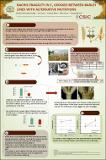Por favor, use este identificador para citar o enlazar a este item:
http://hdl.handle.net/10261/176866COMPARTIR / EXPORTAR:
 SHARE
BASE SHARE
BASE
|
|
| Visualizar otros formatos: MARC | Dublin Core | RDF | ORE | MODS | METS | DIDL | DATACITE | |

| Campo DC | Valor | Lengua/Idioma |
|---|---|---|
| dc.contributor.author | Fernández-Calleja, Miriam | es_ES |
| dc.contributor.author | Casas Cendoya, Ana María | es_ES |
| dc.contributor.author | Pérez Torres, Antonio | es_ES |
| dc.contributor.author | Gracia Gimeno, María Pilar | es_ES |
| dc.contributor.author | Igartua Arregui, Ernesto | es_ES |
| dc.date.accessioned | 2019-02-27T14:01:33Z | - |
| dc.date.available | 2019-02-27T14:01:33Z | - |
| dc.date.issued | 2019-03 | - |
| dc.identifier.citation | II Simposio Español de Fisiología y Mejora de Cereales (Córdoba. 6-7 marzo, 2019) | es_ES |
| dc.identifier.uri | http://hdl.handle.net/10261/176866 | - |
| dc.description | 1 .pdf copy from the original Poster of the Authors presented in the II Simposio Español de Fisiología y Mejora de Cereales (Córdoba. 6-7 marzo, 2019). 4 Figs. Creative Commons License Attribution-NonCommercial-NoDerivatives 4.0 International (CC BY-NC-ND 4.0). | es_ES |
| dc.description.abstract | Two dominant, closely linked and complementary genes, Btr1 and Btr2 control rachis brittleness in barley. Recessive mutations in any of these genes turn the fragile rachis (brittle) into a tough rachis phenotype (non-brittle). The cross of parents with alternative mutations in the btr genes leads to a brittle F1 hybrid that presents grain retention problems. We evaluated rachis fragility at different times after ripening, through a mechanical test and under natural conditions, in F1 crosses with different compositions at the btr genes. Brittleness was significantly higher in Btr1btr1Btr2btr2 crosses compared to hybrids and inbred parents carrying one of the mutations (btr1btr1Btr2Btr2 / Btr1Btr1btr2btr2), measured by means of a mechanic test and spontaneously in the field. This fact could jeopardize the efficient harvest of hybrids bearing alternative mutations, reducing the choice of possible crosses for hybrid barley breeding, and hindering the exploitation of potential heterotic patterns. Furthermore, non-brittle hybrids showed higher brittleness than inbreds, suggesting the presence of other dominant factors affecting the trait. Finally, for the first time, an increase in rachis fragility over time post-maturation was identified, specific to the hybrid genotypes, both brittle and non-brittle types. This increase in rachis fragility with time was only observed by mechanical threshing, but could result in an agronomic problem if it led to head shattering. In conclusion, this work encourages a deeper study of the genetic control of the rachis brittleness trait and urges the consideration of rachis tenacity as a target for hybrid barley breeding. | es_ES |
| dc.language.iso | eng | es_ES |
| dc.rights | openAccess | en_EN |
| dc.subject | Brittle rachis | es_ES |
| dc.subject | Barley | es_ES |
| dc.subject | heterosis | es_ES |
| dc.subject | yield loss | es_ES |
| dc.title | Rachis brittleness in F1 barley crosses with different combinations at the non-brittle rachis genes | es_ES |
| dc.type | póster de congreso | es_ES |
| dc.description.peerreviewed | Peer reviewed | es_ES |
| dc.embargo.terms | 2019-03-04 | es_ES |
| dc.rights.license | https://creativecommons.org/licenses/by-nc-nd/4.0/ | es_ES |
| dc.relation.csic | Sí | es_ES |
| oprm.item.hasRevision | no ko 0 false | * |
| dc.contributor.orcid | Casas Cendoya, Ana María [0000-0003-3484-2655] | es_ES |
| dc.contributor.orcid | Gracia Gimeno, María Pilar [0000-0002-4434-9015 ] | es_ES |
| dc.contributor.orcid | Igartua Arregui, Ernesto [0000-0003-2938-1719] | es_ES |
| dc.type.coar | http://purl.org/coar/resource_type/c_6670 | es_ES |
| item.languageiso639-1 | en | - |
| item.fulltext | With Fulltext | - |
| item.openairecristype | http://purl.org/coar/resource_type/c_18cf | - |
| item.cerifentitytype | Publications | - |
| item.grantfulltext | open | - |
| item.openairetype | póster de congreso | - |
| Aparece en las colecciones: | (EEAD) Comunicaciones congresos | |
Ficheros en este ítem:
| Fichero | Descripción | Tamaño | Formato | |
|---|---|---|---|---|
| Fernandez-CallejaM-2_IISimpEspFisMejCer_2019.pd.pdf | 1,29 MB | Adobe PDF |  Visualizar/Abrir |
CORE Recommender
Page view(s)
391
checked on 22-abr-2024
Download(s)
162
checked on 22-abr-2024
Google ScholarTM
Check
Este item está licenciado bajo una Licencia Creative Commons

